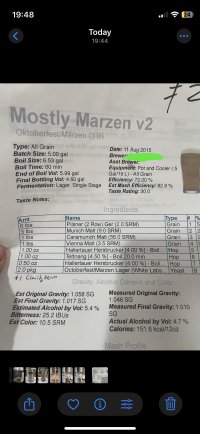Tomas Ramirez
Member
- Joined
- Oct 31, 2023
- Messages
- 14
- Reaction score
- 5
Hey everyone,
Brewed my first pils couple weeks ago and to my surprise i actually hit all my number perfectly.
Sampled my beer when i took my FG reading/ bottled the beer and it tasted great.
let sit for two weeks for bottle conditioning then put one in the fridge overnight for a sampler.
when i poured it aroma was nice a little hoppy (morebeer's pacific coast pils)
when i went in for a taste absolutely PUTRID hahaha first thought, poisonous.
almost has a spray can taste to the back of the mouth.
any ideas??
"the numbers"
OG- 10.51
FG- 10.10
FREM TEMP- 62-70f
DIF- 42 DAYS
YEAST- E491 CELLAR SCI
Brewed my first pils couple weeks ago and to my surprise i actually hit all my number perfectly.
Sampled my beer when i took my FG reading/ bottled the beer and it tasted great.
let sit for two weeks for bottle conditioning then put one in the fridge overnight for a sampler.
when i poured it aroma was nice a little hoppy (morebeer's pacific coast pils)
when i went in for a taste absolutely PUTRID hahaha first thought, poisonous.
almost has a spray can taste to the back of the mouth.
any ideas??
"the numbers"
OG- 10.51
FG- 10.10
FREM TEMP- 62-70f
DIF- 42 DAYS
YEAST- E491 CELLAR SCI


























![Craft A Brew - Safale S-04 Dry Yeast - Fermentis - English Ale Dry Yeast - For English and American Ales and Hard Apple Ciders - Ingredients for Home Brewing - Beer Making Supplies - [1 Pack]](https://m.media-amazon.com/images/I/41fVGNh6JfL._SL500_.jpg)































